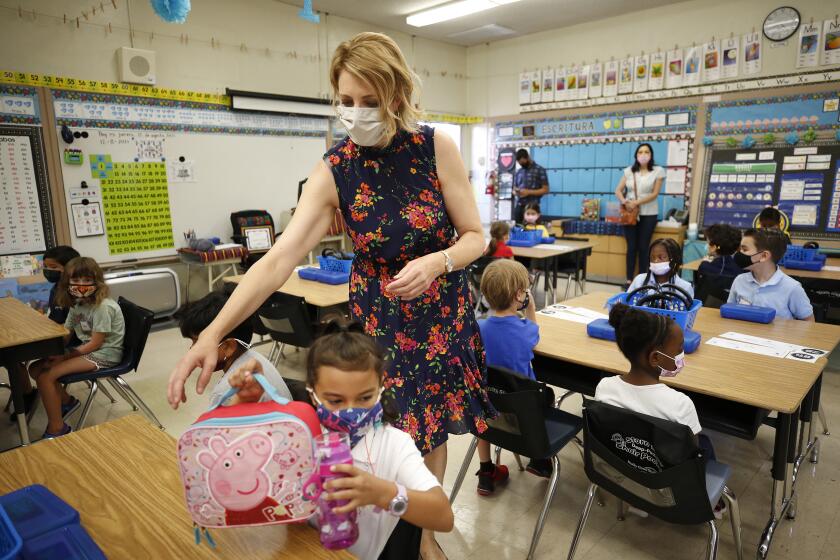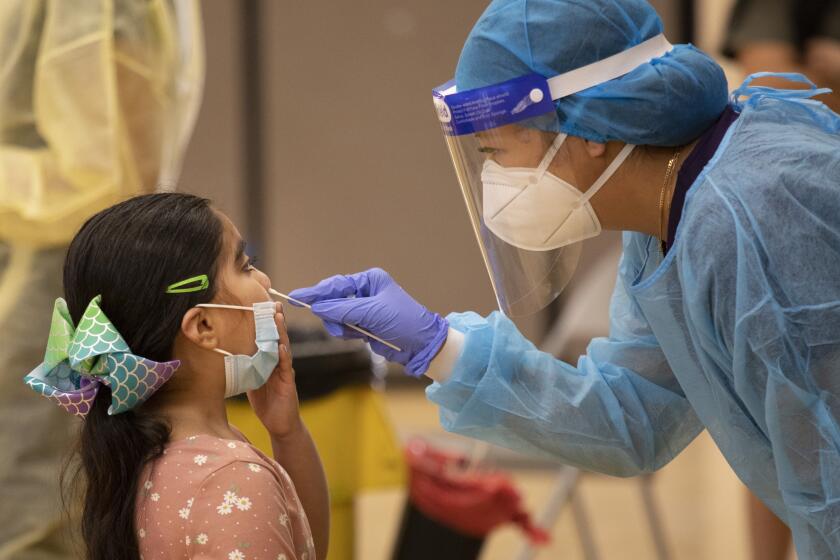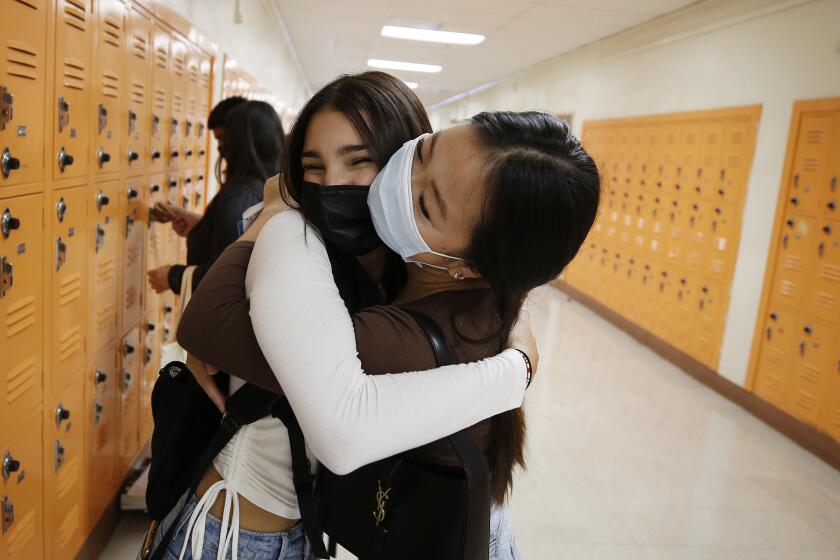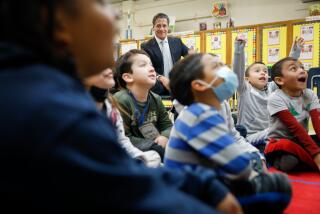LAUSD’s health screening system fails on first day but can’t snuff out excitement

Students and parents endured long lines as daily health checks slowed entry to campuses.
- Share via
Hundreds of thousands of Los Angeles-area students started school Monday, a massive return to in-person education that was marked by pandemic-driven anxiety, a sense of excitement and early-morning frustration over the failure of the district’s health screening system, which caused long waits to enter campuses.
The scenes from the nation’s second-largest school district included the familiar: Yellow buses hit the street on 1,500 routes; the youngest children and their parents exchanged tearful hugs and goodbyes; friends enjoyed happy reunions; teachers felt the jitters of standing before students after the long absence.
The morning also revealed signs of the times: masked students, weekly coronavirus testing, backpacks filled with hand wipes and sanitizer — and an online daily health screening that collapsed at the moment it was needed most.
Lines of anxious students and parents formed down sidewalks and around corners as they waited up to an hour to access campuses after the “Daily Pass” system failed to keep up with demand and was unable to process required health checks.
At campuses throughout the sprawling district, students were delayed from entering schools for 30 minutes, an hour or more. The problem seemed especially acute at high schools, with many students missing their first classes.
“You’ve got the normal chaos of the first day of school, with the added COVID layers,” said school board member Nick Melvoin, who called the performance of the health screening system a disappointment. “But we’re getting through it. And I think everyone’s excited to be back at school.”
Students or parents are supposed to log on to a district website every morning before school to receive a pass. The software asks whether students have a cough, fever or fatigue. If students say they are feeling well, with no symptoms of illness, the system issues a pass with a scannable code for that day. The pass can be printed out or scanned at the entrance to the school, much like an event ticket.
The computer-generated pass is not mandatory — those without it can answer screening questions on the spot — but it is meant to save time and replace hundreds of on-site student interactions with staff members. But the system was apparently overwhelmed by the volume of traffic Monday and shut down or repeatedly denied access. Teachers and other staff rushed to the school entrance to help with verbal screenings.
Interim Supt. Megan Reilly stopped short of saying that the Daily Pass system had crashed but said it was working more slowly than anticipated because of high volume.
“The district has been working with the vendor and fixing the problem throughout the day to speed it up,” Reilly said. When asked whether long lines to enter campus would be the new norm, she said, “Today is the first day of school. I think we’ll get better and better as each day goes by.”
COVID-19 outbreaks have been increasing in L.A. County schools and programs in recent weeks, although not to the same extent as during last year’s autumn and winter surge.
It was unclear Monday night whether the system had been fixed. District officials did not respond to questions about the system’s status.
One student waiting outside Marshall High in Los Feliz said the lengthy wait had definitely “killed my mood.” He pointed wistfully to the window where his first-period class was taking place.
Parents weighed in via text and email with comments like “disaster,” “complete failure” and “unacceptable.”
Others were simply thrilled to have children back on campus — and were willing to be patient.
“Ultimately, my daughter texted me and said she would wear four masks at school if they asked her to so she can be on campus with her teachers and classmates and friends,” said Jana Fain, whose child attends Franklin Dual Language Middle School in Highland Park. “Her face was brimming with so much joy after school, it broke my heart.”
Some parents questioned the need for Daily Pass, given that it’s based on the honor system and is not mandatory, though officials are pushing families to use it.
School board member Jackie Goldberg said the system has merit.
“Once everyone gets the hang of it, the Daily Pass will let students in more quickly,” Goldberg said. “Also, it is used to book a COVID test, and one can record vaccination information. Can people lie? Of course. But overwhelmingly, people do not.”
As more than 1,000 schools reopen amid rising case counts, the district’s massive coronavirus testing effort is central to keeping schools safe.
At elementary schools, first-day jitters were more pronounced than usual.
“I’m nervous,” said Sandra Espinoza, as she struggled to pull up the Daily Pass site while waiting in line to check in her son Ozil, who is entering kindergarten at Montara Avenue Elementary School in South Gate.
Students across California are returning to a very different school experience. Here are answers to common questions about vaccines, testing, masks and more.
She is worried about the surging Delta variant and about reports that young people are becoming infected.
Still, her son was excited, she said. While in line, he tugged on her shirt, eager to get inside. She snapped a photo of him holding a mini chalkboard.
Because most students have been in remote schooling since March 2020, huge numbers are attending class on campus for the first time — ninth- and 10th-graders at high school, sixth- and seventh-graders at middle school. Many parents kept their children out of kindergarten last year, adding another level of academic and social uncertainty.
Students across California are returning to a very different school experience. Here are answers to common questions about vaccines, testing, masks and more.
Teachers had to explain that students can’t get up to get a snack or use the bathroom whenever they want. And, while sharing is a good thing — be it crayons or food — it’s not so good this year, with the coronavirus circulating.
Among the major challenges was the district’s determination to test every student and employee for a coronavirus infection before allowing them back on campus. The district has about 465,000 students in kindergarten through 12th grade and more than 75,000 employees.
School board members had been updated recently on the results of the baseline testing. Board President Kelly Gonez said that as of the end of last week, less than 1% of students were testing positive for a coronavirus infection — about six students per 1,000. That rate is similar to what was found toward the end of summer school. The rate for employees was seven per 1,000.
The safety protocols at L.A. Unified are being touted as among the strictest in the nation, relying on layers of measures, such as masking, improved ventilation and increased hand-washing. Additionally, on Friday, Reilly announced that all teachers and school staff must be vaccinated against COVID-19 by Oct. 15.
Despite the measures, about 3% of students are starting school online through an independent study program. Making that choice required filling out lengthy forms and leaving behind familiar classmates and teachers — at least for the time being.
Parents who opted to return still express worry. What happens if there is an outbreak at a school? How many students will be sent home, and for how long?
It isn’t clear how forthcoming schools will be — in L.A. Unified and elsewhere — about releasing campus infection information. Coronavirus cases must be reported to the L.A. County Department of Public Health, which will work with school officials to identify close contacts and notify them for follow-up testing and possible quarantines.
Kathy Kuzniar feared the worst, because her daughter, a sophomore in high school, wasn’t looking forward to returning due to COVID anxiety.
“We dropped her off and knew instantly that it was going to be a long day of lines and weirdness for her,” Kuzniar said. “She had to wait in lines way after her first period had ended.” But things began to look up. “She called us at lunchtime and was in good spirits about all of the students she saw who were helping out and providing good information.”
Kuzniar expressed gratitude to the “teachers, staff and administrators who are working so hard to make this happen.”
Times staff writer Paloma Esquivel contributed to this report.
More to Read
Sign up for Essential California
The most important California stories and recommendations in your inbox every morning.
You may occasionally receive promotional content from the Los Angeles Times.
















